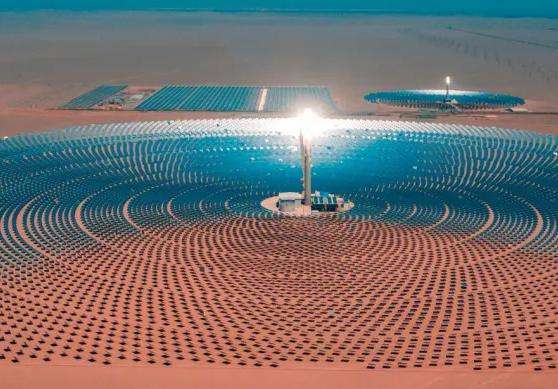1. The reason the ocean is blue
Sunlight is made up of seven types of visible light: red, orange, yellow, green, cyan, blue, and violet. These seven types of light have different wavelengths, and seawater at different depths will absorb light beams of different wavelengths.
After red, orange, yellow and other light beams with longer wavelengths are emitted into sea water, they are gradually absorbed, while blue and cyan light beams with shorter wavelengths are emitted into and encounter seawater. molecules or other tiny particles, floating bodies suspended in the ocean, scatter and reflect in all directions .
In particular, seawater absorbs less blue light and reflects it more. The deeper you go, the more blue light is refracted towardsthe water surface. Therefore, the sea water we see in the ocean is blue. color.
2. Minerals in the ocean
Dilute manganese nodules, oil, seafloor hydrothermal mineral deposits, nickel, copper, cobalt and salt.
3. Marine animals
Lighting zone: (from the water surface to 200 meters underwater) where a large number of planktonic creatures, algae and coral reefs live, except fish and marine mammals. . , there are also a large number of marine invertebrates, such as jellyfish, cephalopods, etc., as well as marine reptiles, seabirds, etc.
Low light zone: (200 meters 1000 meters underwater) Most organisms have large eyes and light-emitting organs, and some animals hide in dimly lit areas during the day and move into shallow water to forage for food at night.
Deep water zone: (below 1,000 meters underwater), the sun's rays never shine here, it is dark all year round, and there is little submerged food. Few animals can survive in the deep sea.
Detailed information:
1. Classification by lifestyle
Marine animals mainly include three ecological types: marine zooplankton, swimming marine animals, and benthic marine animals.
2. Classification system
There are dozens of categories of marine animals, which can be divided into three broad categories: marine invertebrates, marine protozoa, and marine vertebrates.
Marine invertebrates represent the vast majority of marine animals and include the most diverse categories. The main ones are protozoa, sponges, coelenterates, platyhelminths, nematozoa and brachiates, echinoderms and hemichordates, etc.
Marine protochordates are animals living in the ocean between vertebrates and invertebrates, including urochordates and cephalochordates.
Marine vertebrates, including fish, reptiles, birds and mammals that depend on the ocean.
References:
Baidu BaiduFamily - Marine animals
1. Shark
Features:
1. The shark has a hard body, well-developed muscles, and varying degrees of spit shape.
2. The snout and snout vary between species, ranging from pointed to large and round.
3. The vertically ascending tail (caudal fin) is roughly crescent-shaped, and the upper part of the caudal fin of most species is much larger than the lower part.
4. Sharks mainly feed on fish and other marine animals. The great white shark is a camouflaged predator.
2. Whales
Features:
1. Large size Some whales are very large, with the greatest body length reaching 30 meters.
2. The “fountain” breathing method is a unique life habit of whales.
3. The body shape of a whale is like that of a fish, with a spindle shape. The head is large, the eyes are small and the auricles are completely degenerated. The neck is not obvious. The forelimbs are fin-shaped and the hindlimbs are completely degenerated; most species have fins on their backs; the tail is shaped like a horizontal fin and constitutes the main organ of locomotion.
4. Viviparous, usually one calf per litter, and young whales are nursed with milk.
5. Whales have aelm appetite. A blue whale can eat 8 to 10 tons of krill per day.
3. Dolphin
Features:
1. Body length 1.2 to 4.2 meters, weight 23 to 225 kilograms. Dolphins typically have pointed mouths and around 100 sharp teeth in their upper and lower jaws. They feed mainly on small fish, squid, shrimp and crabs.
2. Dolphins like to live a “collective” life, ranging from a few to several hundred.
3. Dolphins are marine mammals with extraordinary abilities and intelligence. After training, you can play table tennis, jump through fire hoops, etc.
4. Jellyfish
Features:
1. She has no spine, but her body is very huge for support. his huge body.
2. The body is shaped like a transparent umbrella. The diameter of the umbrella body can be large or small. The diamBeing the umbrella body of a large jellyfish can reach 2 meters.
3. The hands are covered in stinging cells, like little beans stuck to the tentacles. These stinging cells can shoot venomous threads when they encounter "enemies" or
When it attacks itself. he will shoot venomous threads to frighten the “enemy” or poison him to death.
5. Manatees
Characteristics:
1. Manatees have adapted to life in the water and their forelimbs have specialized into cones, but there are still some. degenerated hooves at the extremities, which are different from ungulates, are closer. The hind limbs gradually recede
and disappear, and the tail is a round whale.
2. Manatees live in shallow tropical seas or deep-water inland rivers and lakes, feeding on various aquatic plants or other aquatic plants.
3. When the manateeis nursing, it will hug its young with its forelimbs, head and chest exposed out of the water, as if a person were swimming in water, which is why it is called "mermaid".














